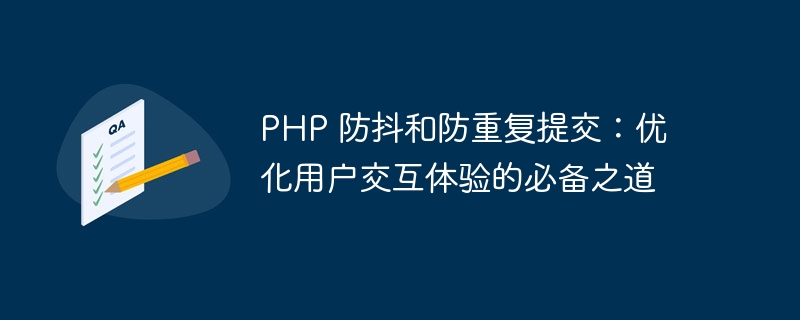Home >Backend Development >PHP Tutorial >PHP anti-shake and anti-duplicate submission: a must-have for optimizing user interaction experience
PHP anti-shake and anti-duplicate submission: a must-have for optimizing user interaction experience
- PHPzOriginal
- 2023-10-12 14:52:501291browse

PHP Anti-Shake and Anti-Duplicate Submission: A must-have for optimizing user interaction experience
When developing web applications, optimizing user interaction experience is very important aspect. Among them, anti-shake and anti-duplicate submission are two very critical technologies that can effectively reduce unnecessary operations and improve user satisfaction. This article will introduce the method of anti-shaking and anti-resubmission in PHP, and provide specific code examples.
1. The concept and principle of anti-shake
Anti-shake means that when the user triggers an event continuously, only the last operation is performed, thereby avoiding unnecessary resources caused by frequent triggering events. waste. In web applications, common trigger events include button clicks, input box inputs, etc.
The principle of achieving anti-shake is very simple: by setting a timer, delay the execution of the operation. If the same event is triggered again before the timer starts counting, the previous timer will be canceled and the time will start again. This way, the action will only actually be performed after the user stops triggering the event for a period of time.
The following is a sample code that uses PHP to achieve anti-shake:
function debounce($callback, $delay) {
$timeout = null;
return function() use ($callback, $delay, &$timeout) {
if ($timeout) {
clearTimeout($timeout);
}
$timeout = setTimeout($callback, $delay);
};
}
// 使用示例
$debouncedFn = debounce(function() {
// 这里是需要防抖的操作
}, 500);
// 调用防抖函数
$debouncedFn();In the above code, the debounce function accepts two parameters: $callback is the operation that needs to be performed, $delay is the time to delay execution. The function uses a closure internally and maintains a $timeout variable to save the reference to the timer. When the user triggers an event, the previous timer is cleared and a new timer is reset.
2. The Concept and Principle of Anti-Duplicate Submission
Anti-duplicate submission means that when a user repeatedly submits the same request, only one request will be processed to avoid the impact of repeated operations on the data. In web applications, common repeated submission scenarios include form submissions, interface requests, etc.
The principle of preventing repeated submission is also very simple: when the user submits a request, the request identification is stored on the server side. If the same request is received again next time, it will be judged that the request has been processed, and the request will be processed directly. Return results. This can be achieved using storage methods such as Session or database.
The following is a sample code that uses PHP to prevent duplicate submissions:
function preventDuplicate($key) {
session_start();
if ($_SESSION[$key]) {
die('不能重复提交!');
} else {
$_SESSION[$key] = true;
}
}
// 使用示例
preventDuplicate('submit_key');
// 处理表单提交逻辑
// ...In the above code, the preventDuplicate function accepts a parameter $key , used to identify whether the request has been processed. The function uses Session internally to store the request ID. If the ID already exists, it means that the request has been processed and the prompt message "cannot be resubmitted" will be returned directly.
3. Application scenarios of anti-shake and anti-repetitive submission
- Application scenarios of anti-shake:
- Prevent repeated clicks on buttons to avoid Frequently initiate requests;
- Dynamic search data based on user input to reduce invalid requests.
- Application scenarios for preventing repeated submission:
- Form submission to avoid data redundancy caused by repeated insertion into the database;
- Payment page to avoid repeated payment requests;
- interface requests to avoid repeated important operations.
Through the reasonable use of anti-shake and anti-resubmission technologies, the user interaction experience can be effectively optimized and unnecessary operations and resource waste can be reduced. In actual development, according to specific needs and scenarios, appropriate methods are selected for implementation, and appropriate customization and optimization are carried out according to specific business needs.
Summary
This article introduces the concepts, principles and implementation methods of anti-shaking and anti-repetitive submission in PHP, and provides specific code examples. By applying anti-shake and anti-resubmission, the user's interactive experience can be improved and unnecessary operations and resource waste can be reduced. In actual development, we should rationally select and apply these technologies according to specific needs and scenarios to achieve the best results.
The above is the detailed content of PHP anti-shake and anti-duplicate submission: a must-have for optimizing user interaction experience. For more information, please follow other related articles on the PHP Chinese website!
Related articles
See more- JS simple implementation of anti-shake - debounce and throttling - throttle
- Introduction to application scenarios of javascript function throttling and anti-shake
- Best practices for anti-shaking and anti-resubmission in PHP
- Principles and applications of PHP anti-shake and anti-duplicate submission technology

